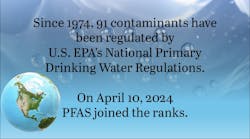The enduring threat of PFAS: a water expert's perspective
Imagine a chemical so resilient that it can withstand temperatures of 800 degrees Celsius, remain intact when exposed to strong acids or bases, and even shrug off attempts by bacteria to break it down. This seemingly indestructible substance exists, and it's known as per- and polyfluoroalkyl substances (PFAS), a group of synthetic chemicals.
However, in recent years, a disturbing truth about PFAS has emerged: this seemingly wonderful chemical harbours a sinister side. When PFAS enters the bodies of humans and animals through contaminated water, air, or soil, it poses a significant health threat. Studies have linked PFAS exposure to a range of serious health issues, including cancer, liver damage, and thyroid dysfunction.
With the realities of PFAS uncovered, regulatory agencies around the world have been working to establish guidelines and standards for PFAS in drinking water. These emerging regulations mark a paradigm shift in drinking water quality, placing PFAS as a priority contaminant. Compliance poses a formidable challenge for water utilities.
In fact, water utilities are given a three-year window, until 2027, to conduct initial testing for PFAS in their drinking water supplies. By 2029, any public water system exceeding the MCLs must take action to reduce PFAS levels and notify the public of the violation.
Navigating the complex nature of PFAS treatment
It's imperative to recognize that there's no one-size-fits-all solution for treating PFAS. The selection of a PFAS treatment technologies depends on site-specific factors, including contaminant profile, water quality, and regulatory requirements, necessitating a holistic approach to treatment planning. As we anticipate future changes in water quality and regulatory standards, the pursuit of the optimal techno-economic solution demands thorough analysis tailored to individual cases, encompassing not only PFAS remediation but also broader treatment objectives.
Addressing PFAS contamination requires a comprehensive understanding of treatment mechanisms, efficiency, and the economic viability of available technologies. The PFAS treatment approach is divided into three stages: removal, concentration, and destruction, focusing on the mechanisms that influence each stage and the techno-economic analysis of proven treatment methods.
Proven technologies recommended by the EPA for PFAS removal include GAC, IX, and membrane treatments such as nanofiltration and reverse osmosis. The removal of PFAS from water involves transferring the contaminants from the treated stream to fixed media or another liquid stream. Key mechanisms influencing PFAS removal include hydrophobic and electrostatic interactions that directly depend on water composition, competing organic and inorganic species, and future changes in feed water. Hence pilot studies play a crucial role in determining the optimal treatment technology for a specific site.
GAC, with its long-standing history in water treatment, remains a viable option for PFAS removal. With this treatment carbon source type, media life and feasible disposal options must be considered and evaluated. While GAC treatment is cost-effective and suitable for long-chain PFAS, it is sensitive to organic load presence in treated water and requires larger footprint and retention time compared to IX technologies.
IX resins offer high selectivity for PFAS removal but are sensitive to competing anions in feed water. Proper management of resin exhaustion and disposal is essential due to their single-use nature.
Membrane technologies, although more costly, are more suitable for high-flow applications and address a variety of emerging contaminants effectively. While they offer higher removal efficiencies and broader PFAS molecule size range, they require careful consideration of operating parameters such as water quality, permeate remineralization and brine disposal.
Nevertheless, it's essential to acknowledge that all three treatment technologies are sensitive to lack of robust pretreatment and generate waste, whether in the form of solid residuals from GAC and IX processes or continuous liquid discharge from membrane systems.
Addressing the disposal of solid waste presents a significant challenge, with limited options ranging from landfilling to incineration. However, evolving regulations such as CERCLA and RCRA intensify the complexity and cost associated with solid waste management, casting doubt on the long-term viability of conventional disposal methods.
The financial landscape of PFAS regulation: challenges and opportunities
The EPA’s new NPDWR for PFAS presents a significant financial challenge for US Public Water Systems (PWS). While the EPA estimates annual compliance costs at $1.5 billion, a 2023 study by Black & Veatch suggests a higher figure exceeding $3.8 billion annually.
Potential funding solutions may include:
- Government Initiatives: The Bipartisan Infrastructure Law allocates substantial funding for water infrastructure, including $10 billion over five years for grants to address PFAS and emerging contaminants. Additionally, other water improvement projects receive $12 billion.
- Industry Settlements: The recent court-approved settlement with 3M provides $10.3 to $12.5 billion to support PWS nationwide in addressing PFAS contamination.
While these funding sources are significant, they may not fully cover all treatment costs. Potential approaches could include:
- Public-Private Partnerships (P3s): By partnering with private companies, PWSs can leverage expertise, accelerate project timelines, and achieve optimal capital and operational expenditure (capex-opex) management. P3s can expedite the process by streamlining procurement and utilizing private sector experience. This reduces development time and costs.
- Risk Sharing: Collaborative risk management allows each party (public and private) to assume risks they are best equipped to handle, ultimately reducing overall project costs and water prices.
Partnering with technology and operations specialists ensures plant design for efficient long-term operation, minimizing lifecycle costs through optimized capex-opex strategies.
The evolution of PFAS destruction technologies
As destruction technologies for PFAS contamination continue to evolve, it's crucial to differentiate between transformation and mineralization processes. Transformation involves the partial degradation of PFAS molecules, breaking them down into shorter forms that may still pose contamination risks, sometimes even generating more toxic byproducts.
Mineralization, on the other hand, signifies complete destruction without producing harmful residues, resulting in the conversion of PFAS into innocuous substances like inorganic fluorine. Evidence of successful destruction includes reduced PFAS concentrations, the production of end products such as hydrofluoric acid, carbon dioxide, and heat release, as well as the closure of mass balances accounting for inorganic fluoride.
However, despite advancements, fully developed commercial destruction technologies remain elusive. There are many considerations to take into account when evaluating destruction systems including the type of waste input required,solid or liquid and economic feasibility thresholds based on PFAS concentrations, operational modes, reaction times, necessary chemicals, and energy consumption. Sustainability remains a challenge, with the potential for byproduct formation necessitating post-treatment polishing. For instance, electrochemical oxidation may yield perchlorate, if chloride ions are present in the treated stream. Given the complexity of these factors, expert evaluation is indispensable. While strides are being made, comprehensive commercial destruction solutions for PFAS contamination are still in development.
Charting the path of PFAS regulations and water safety
The gravity of the PFAS situation has not gone unnoticed. Governments, technology companies, and research institutes worldwide are mobilizing to address this growing concern. Efforts are underway to restrict PFAS use, enhance monitoring capabilities, develop viable alternatives, and remediate contaminated sites.
While the current focus of PFAS regulations is on drinking water, there is growing concern about the presence of PFAS in wastewater and its potential impact on the environment and human health. PFAS can enter wastewater streams from various sources, including industrial discharges, landfill leachate, and domestic sources. As awareness of PFAS contamination in wastewater increases, regulatory agencies are expected to develop guidelines and standards for PFAS in wastewater discharges.
These regulations may require municipalities and industries to implement additional treatment processes or pretreatment measures to remove PFAS from wastewater before discharge. Furthermore, the potential for PFAS to accumulate in biosolids generated during wastewater treatment raises concerns about the land application of these materials. Stricter regulations and guidelines for the management and disposal of PFAS-containing biosolids may be forthcoming.
In summary, the regulation of PFAS in water is a rapidly evolving field, and water utilities, municipalities, and industries must stay informed and proactive in addressing this emerging contaminant. Collaboration between regulatory agencies, water treatment experts, and stakeholders will be crucial in developing effective and sustainable solutions to protect public health and the environment.
Let’s partner for a cleaner future
The EPA's PFAS regulations represent a necessary step towards cleaner drinking water, but they also create financial challenges for PWSs. By exploring innovative financing options like P3s and partnering with experienced technology providers, PWSs can navigate these challenges and deliver cost-effective PFAS treatment solutions. As we explore the evolving landscape of PFAS treatment, it's imperative to embrace a multifaceted approach that balances efficacy, sustainability, and regulatory compliance, ensuring the safeguarding of water resources for generations to come.
About the Author
Marina Shulman
Marina, a process team leader at IDE, the world leader in desalination and water treatment solutions initially joined the company as a process engineer in 2018 and contributed significantly to the QBII process team. Transitioning to the IWT team, she played a pivotal role in a major Semiconductor industry project, demonstrating her versatility and expertise. Marina actively engages in company tenders and initiatives and leads forums and developments within her division. Holding a Master’s degree in Environmental Engineering technology from the Technion, Israel Institute of Technology, Marina combines academic rigor with hands-on experience to deliver impactful solutions in the field of water treatment and environmental engineering.
Zeev Kiessel
Zeev Kiessel is a seasoned finance executive with a wealth of experience in driving financial strategy and operational excellence across diverse industries. Currently serving as Senior Analyst - M&A and Corporate Development at IDE, the world leader in desalination and water treatment solutions, Zeev plays a pivotal role in driving strategic initiatives and maximizing value creation. Prior to his current role, Zeev held key positions in prominent organizations, including serving as an M&A consultant at PwC and as a Senior Associate at Ernst & Young. Armed with a CPA licence and an MBA from Tel Aviv University, Zeev leverages his expertise to deliver impactful financial solutions that drive business growth and profitability.


